Shrimp
Approximately 23% of all shrimp species prefer to live in freshwater
Advertisement
Shrimp Scientific Classification
Read our Complete Guide to Classification of Animals.
Shrimp Conservation Status
Shrimp Facts
- Main Prey
- Snails, dead shrimp, worms, fish
- Group Behavior
- School
- Fun Fact
- Approximately 23% of all shrimp species prefer to live in freshwater
- Estimated Population Size
- Millions
- Biggest Threat
- Consumption by other sea animal life
- Most Distinctive Feature
- Has 10 legs
- Gestation Period
- 2-3 weeks
- Optimum pH Level
- 7.0-9.5
- Habitat
- All water regions around the world
- Predators
- Crabs, sea urchins, starfish, seabirds, whales, sharks, seahorses, dolphins, and humans
- Diet
- Omnivore
- Favorite Food
- Tiny Fish
- Type
- Crustacean
- Common Name
- Shrimp
- Average Clutch Size
- 500000
- Slogan
- There are 2,000 different species worldwide!
View all of the Shrimp images!
Shrimp are crustaceans, and they are closely related to lobsters.
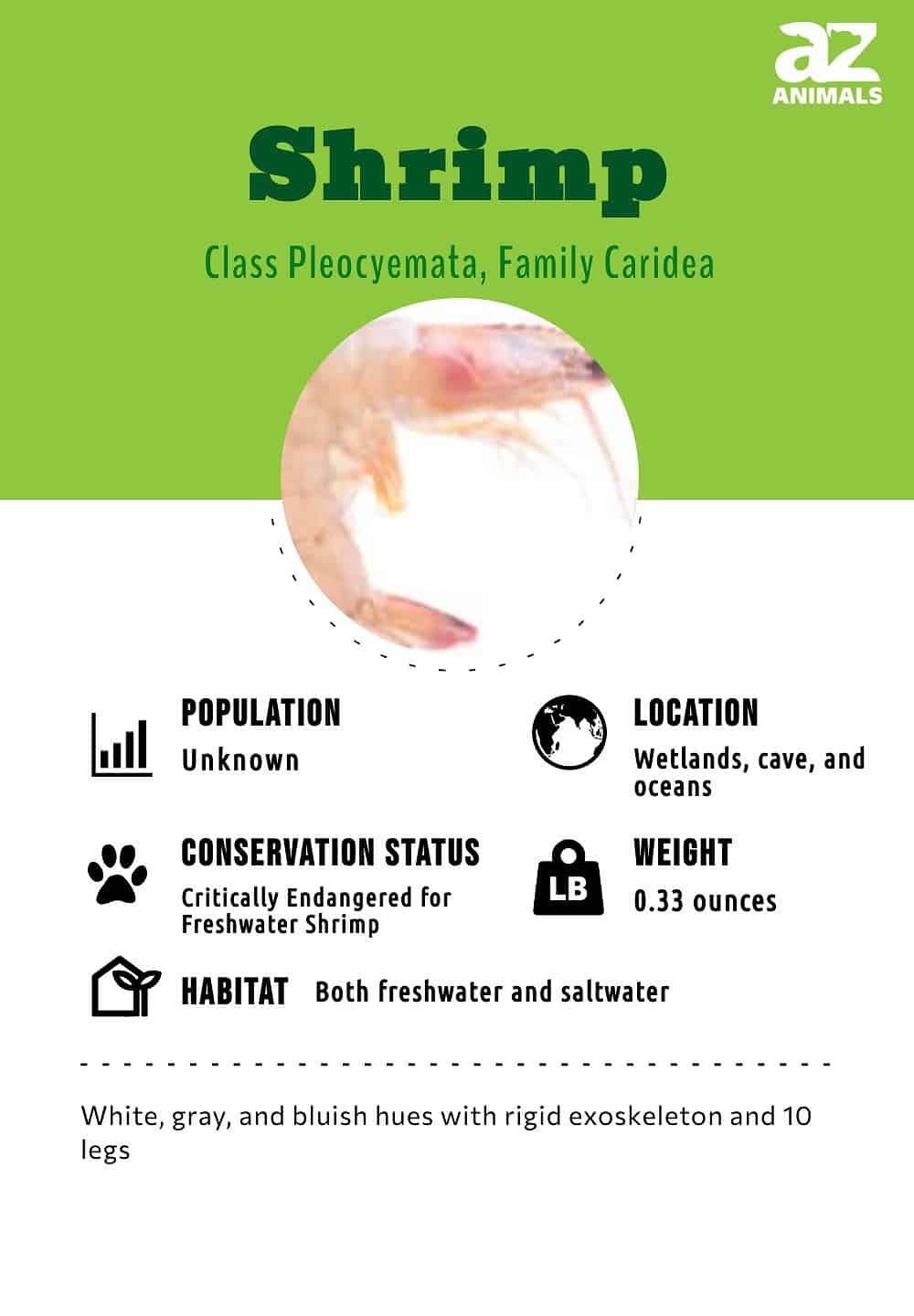
Shrimp vs. Prawn
While the terms “shrimp” and “prawn” are typically used interchangeably among different nations, the two types of crustaceans are much different. Both shrimp and prawns are decapods, which means that they both have ten legs. However, while shrimp are closely related to the lobster, crayfish, and crab, prawns are in their own suborder – dendrobranchiate.
See all of our expert product reviews.
Prawns have longer legs, and they don’t bend in the same flexible way that the shrimp can. While the prawn will release eggs into waters to eventually let them hatch and live alone, shrimp carry their eggs with them after fertilization.
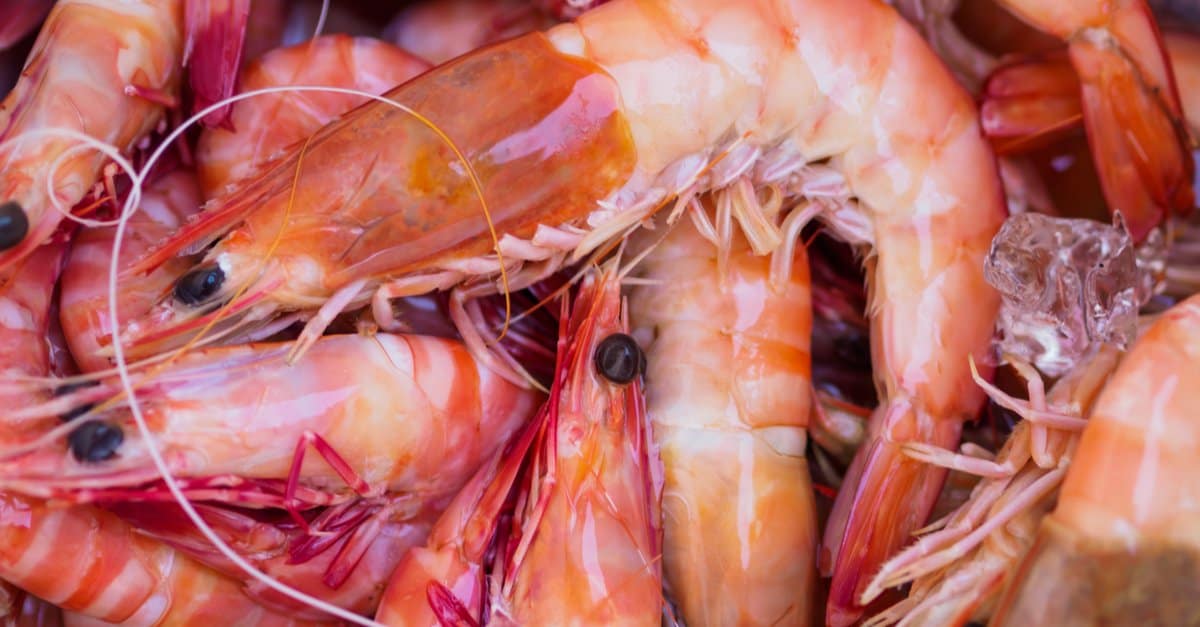
One of the largest “shrimp” is this Eastern King Prawn.
©burnettj/Shutterstock.com
A problem with this confusion of terms is that many prawns are named as shrimp. For example, the Atlantic white shrimp (Litopenaeus setiferus), which has multiple other names all ending in “shrimp,” is actually a species of prawn found along the coast of North America and in the Gulf of Mexico. In fact, the first “shrimp” fishery in the United States was established for this prawn.
3 Incredible Shrimp Facts!
- There are 57 species that date back to the Lower Jurassic and Cretaceous eras.
- Several ports on the coasts of the United States claim to be the “shrimp capital” of the entire world.
- Though “shrimp” is often used to refer to something small, there’s no indication of how that correlation began.
You can check out more incredible facts about shrimps.
Health and Entertainment for your Shrimp
See all of our expert product reviews.
Classification and Scientific Name
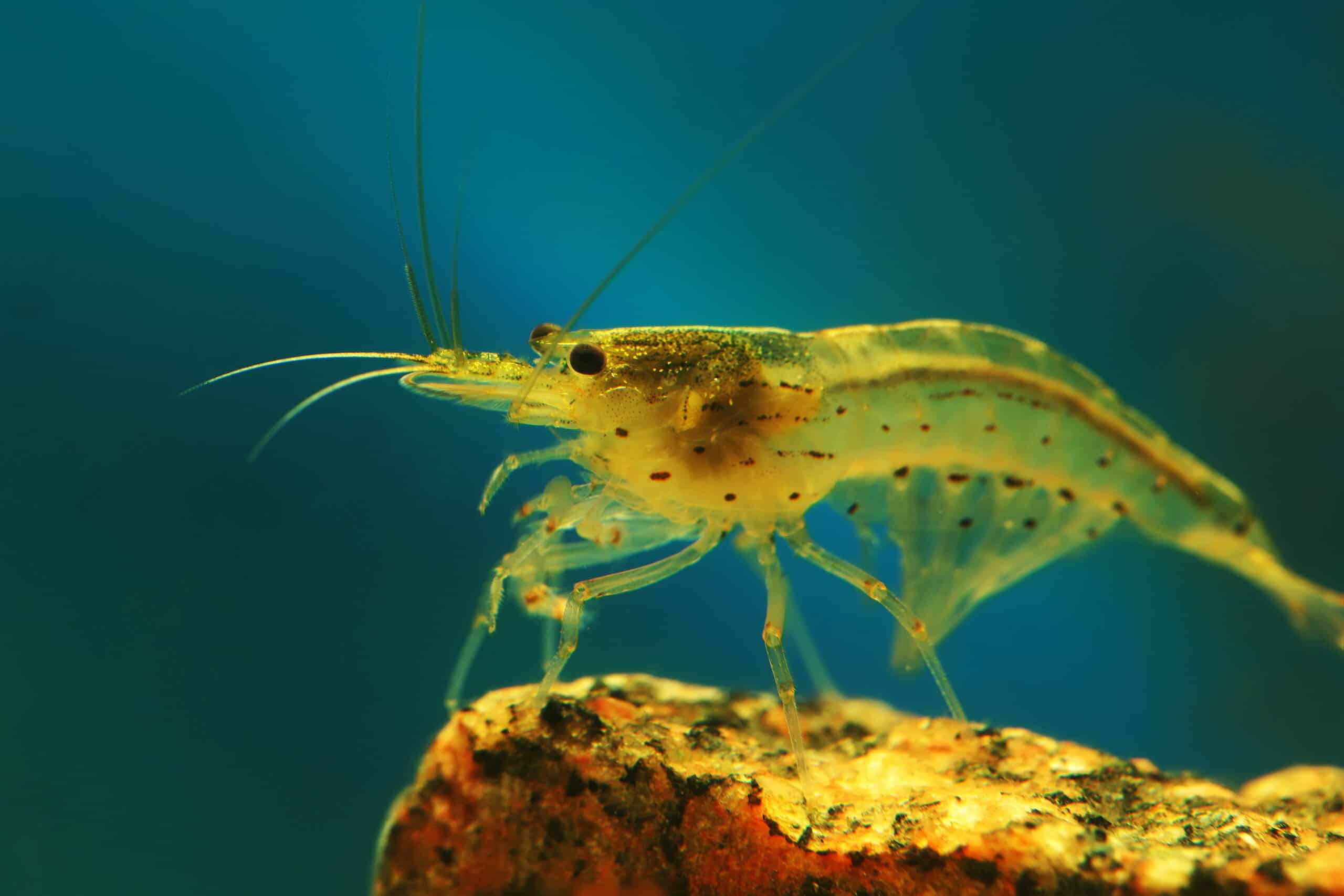
The amano shrimp (Caridina multidentata) is only one of 300 subspecies of shrimp.
©Grigorev Mikhail/Shutterstock.com
The shrimp is a member of the class Pleocyemata, family Caridea,. There are over 300 subspecies, and each one has its own scientific name as well.
All shrimp were once saltwater creatures, but they spread out and evolved into a freshwater existence as well. In addition, many shrimp species have developed a sympiotic relationship with other organisms such as corals, fishes, tunicates and sponges.
The word “shrimp” seems to be rooted in 14th century Middle English. It comes from the German word “schrempen,” which means “to contract or wrinkle.” This may be a description of their curled bodies.
Species
In total, there are over 300 different species of shrimp in the world, often differentiated by their color description. Some of the most common commercial species include:
- Whiteleg shrimp (Litopenaeus vannamei): A prawn found in the Pacific Ocean, it can grow up to 9.1 inches.
- Pink shrimp (Pandalus borealis): They live primarily in the northern areas of the Atlantic and Pacific Oceans.
- Akiami paste shrimp (Acetes japonicus kishinouye): a shrimp species from the family Sergestidae, it is often sold dried or salted. This is the most commonly fished species in Japan.
- Red Cherry Shrimp (Neocaridina davidi): This species originated in eastern China but is now also in Taiwan, Japan, and Hawaii, and is popular for aquaria.
- Amano Shrimp (Caridina multidentata): Popular for aquariums, the Amano shrimp goes by many names, including the Yamato shrimp, Japanese shrimp, and algae shrimp. Native to Taiwan and Japan, they primarily feed on algae, hence their name.
Appearance
While alive, these animals are often found in white, gray, and light bluish hues, though the animal species will determine the color.

A rigid exoskeleton can be seen on this Asian glass shrimp (
Macrobrachium lanchesteri).
©Alex Stemmers/Shutterstock.com
The shell of the animal is made from a material called chitin, which is a thin but rigid exoskeleton. However, since they have no inner skeleton, they are not part of the fish family. They have 10 legs (which is the definition of a decapod), and they are in the same family as crabs and lobsters. Most of them are only about 2 cm long, but some species are bred to be bigger.
Distribution, Population, and Habitat
The habitat varies from one species to another. Freshwater is preferred by approximately 23%, though most species will primarily rest at the bottom of the waters they live in. Shrimp are rather resilient, living in both warm and cold water throughout the world’s oceans in depths of up to 16,000 feet.
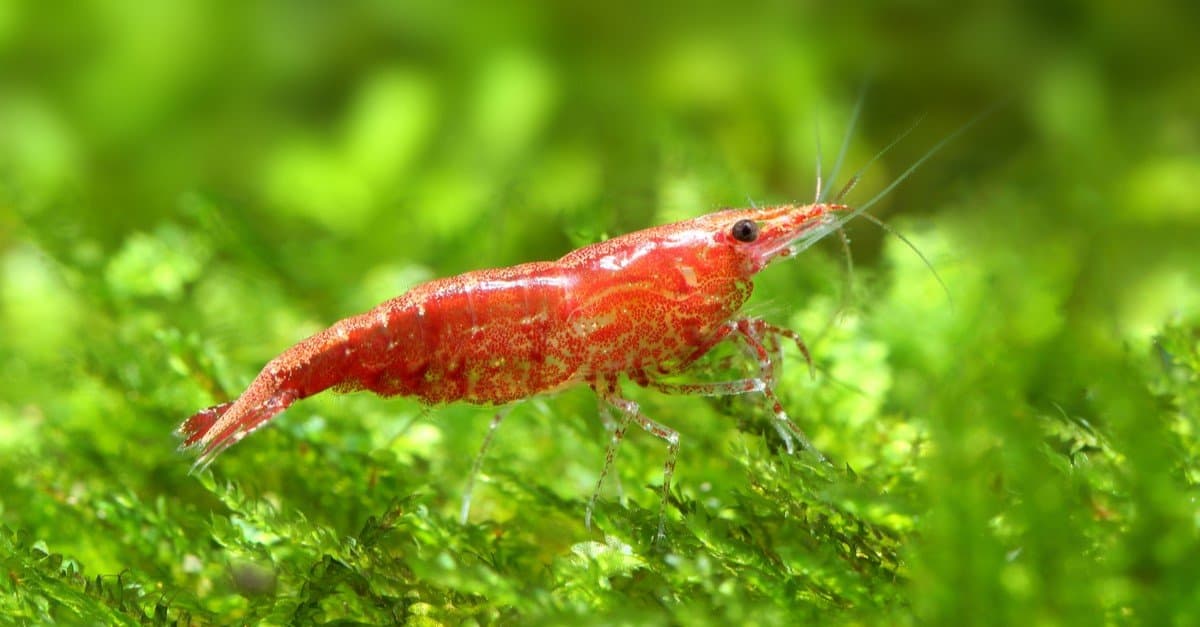
Red Cherry Shrimp sitting on plants in an aquarium.
©topimages/Shutterstock.com
With the right care, shrimp can be kept in an aquarium. They require high-quality water, and any owner should check the particular type of water needed for the species. Appropriate plants and algae should be provided as natural sources of food in their aquarium.
With hundreds of species around the world, only 20 of these species have made their way into commercial use. However, shrimp are the prey of most everything in the saltwater oceans.
As to freshwater shrimp, nearly 28% of the world’s species are threatened with extinction. This situation results from habitat degrdation and destruction. For example, many species of shrimp prefer wetlands as a habitat, but wetlands are rapidly disappearing. Shrimp that live in caves are vulnerable to human actions such as groundwater extractions, water contamination, and excessive silt.
Predators and Prey
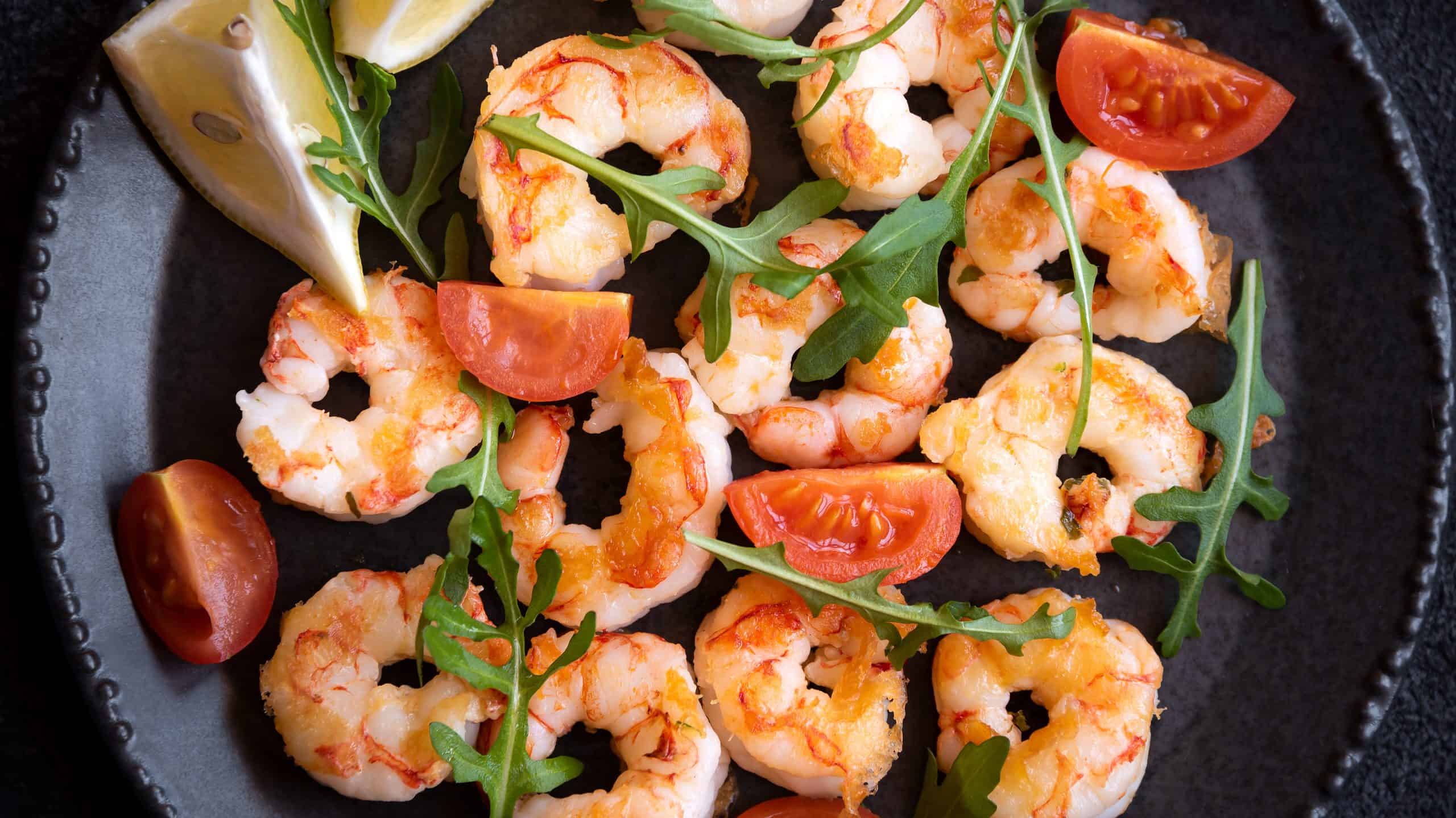
Cooked shrimp, a favorite of human predators.
©Maria_Usp/Shutterstock.com
The diet of these animals is broad. Shrimp are not picky, and they’ll grab the food that they can survive. Their typical food consists both of plants and sea animals that are typically smaller than them, which is what makes them omnivorous.
What eats shrimp?
Shrimp are are hunted by the majority of carnivores and omnivores in the ocean. Some of their natural predators include crabs, sea urchins, starfish, seabirds, whales, sharks, seahorses, and dolphins. Shrimp are also consumed by humans.
What do shrimp eat?
They will eat just about anything that they find, including dead or living plants, worms, fish, snails, and algae. If necessary, they’ll eat other dead shrimp as food too. For a complete analysis of their diet, give our ‘What Do Shrimp Eat?’ page a read!”
Reproduction and Lifespan
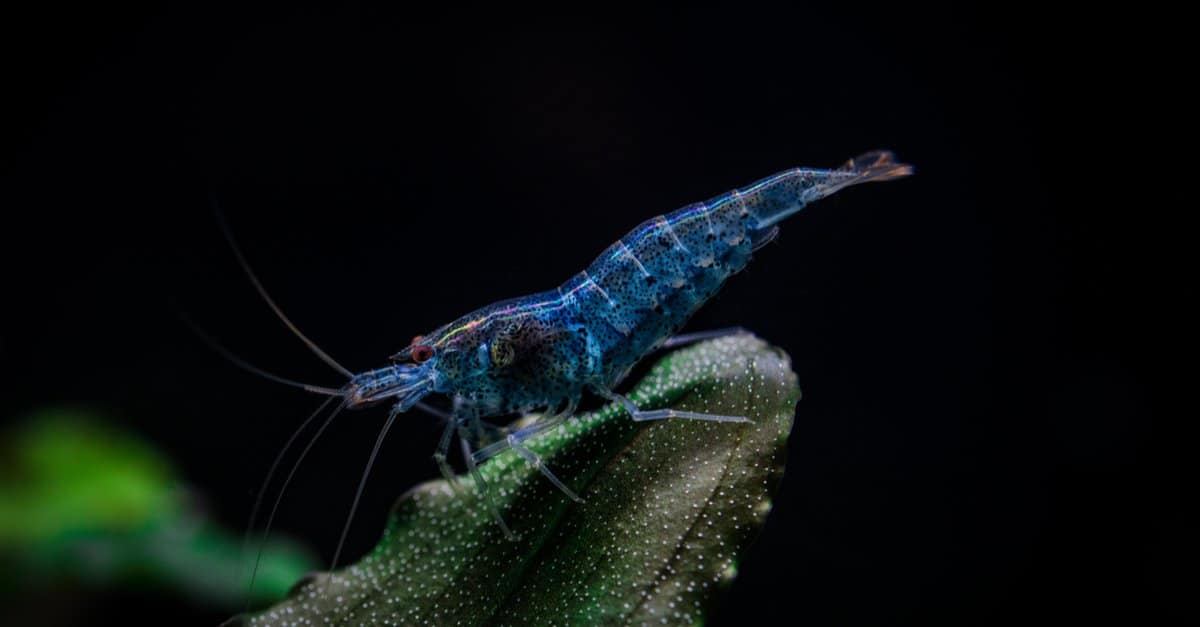
Shrimp, like the aura blue
tiger
shrimp, can live up to 6 years if not eaten by another sea animal.
©Shrimplake/Shutterstock.com
As the female shrimp mates, she’ll store the sperm, which means that one group of fertilized eggs may come from multiple males. Once the eggs are fertilized, the parent will carry them along on her belly until they are ready to hatch. The clutch size is typically 50,000 to 1 million. Shrimp can be stressed when laying eggs, if kept in an aquarium, and that may cause them to abandon their young.
If the animal is not captured before the end of its natural lifespan, it could live up to six years old.
Fishing and Cooking
These animals have been used in many seafood menus in restaurants across the United States. Cooking this fish at home is fairly versatile, since it can be grilled, baked, sauteed, and more. There are very few cooking websites online that don’t at least touch on a few shrimp recipes. Shrimp take on other flavors easily, though they can also be served cold with some cocktail sauce. Even consuming 3 ounces of shrimp is 18 grams of protein.
Like many shellfish, the color of the flesh brightens while cooking, going from a whitish-gray hue to a vibrant red or pink exterior with white inner flesh. While the majority of people prefer to remove the chitin (shell), deep-frying shrimp can be a delectable and crispy treat.
View all 293 animals that start with SShrimp FAQs (Frequently Asked Questions)
Are Shrimps herbivores, carnivores, or omnivores?
Shrimps are Omnivores, meaning they eat both plants and other animals.
What Kingdom do Shrimps belong to?
Shrimps belong to the Kingdom Animalia.
What phylum do Shrimps belong to?
Shrimps belong to the phylum Arthropoda.
What family do Shrimps belong to?
Shrimps belong to the family Caridea.
What order do Shrimps belong to?
Shrimps belong to the order Decapoda.
What type of covering do Shrimps have?
Shrimps are covered in shells.
In what type of habitat do Shrimps live?
Shrimps live in all water regions around the world.
What do Shrimps eat?
Shrimps eat tiny fish, algae, and plankton.
What are some predators of Shrimps?
Predators of Shrimps include fish, crabs, and whales.
What is the average clutch size of a Shrimp?
Shrimps typically lay 500,000 eggs.
What is an interesting fact about Shrimps?
There are 2,000 different species of Shrimp worldwide!
What is the lifespan of a Shrimp?
Shrimps can live for 1 to 2 years.
What is the optimal pH for a Shrimp?
The optimal pH for a Shrimp is between 7.0 and 9.5.
How do Shrimps have babies?
Shrimps lay eggs.
What is a shrimp?
A shrimp has a long body and moves via locomotion. This type of sea life is a type of decapod crustacean, and it is not categorized under the same family as a fish because they have no internal skeleton.
Is the shrimp the same as a prawn?
No. Though the species may seem similar, they are in entirely different sub-orders. The shrimp is part of the Pleocyemata sub-order, while the prawn is part of the Dendrobranchiata sub-order.
Can dogs eat shrimp?
Absolutely. Shrimp are an incredible source of nutrients for dogs, offering vitamin B12, antioxidants, niacin, and phosphorus (according to current nutritional facts on the animal). They are low in fat, but they are high in cholesterol. Serving a dog shrimp should be a special treat.
What eats shrimp?
Shrimp are hunted by many types of sea life, including other fish, sea mammals, and puffins. Many humans enjoy shrimp in casual or fine dining recipes.
Are shrimp fish?
No. According to their taxonomy description, shrimp are decapod crustaceans.
Where are shrimp found?
Shrimp can be found in both freshwater and saltwater oceans.
Do shrimp have an exoskeleton?
Yes. This outer shell is called chitin.
What is the difference between a krill and a shrimp?
The greatest differences between krill and shrimp include their size, morphology, and body color. Krill are smaller than shrimp. The former has a body with three segments rather than the two that shrimp have, and have a mostly transparent exoskeleton with pink hues instead of the shrimp’s distinct pinkish brown color.
What is the differene between a pistol shrimp and a mantis shrimp?
The greatest differences between pistol shrimp and mantis shrimp are their families, methods of attack, and morphology. Pistol shrimp, also called Alpheidae, are true shrimp but mantis shrimp (Stomatopoda) are not actually shrimp. Pistol shrimp use their unique claws to generate a weaponized bubble that slams into creatures, but mantis shrimp use a spear or hammer to stab or smash their foes.
Thank you for reading! Have some feedback for us? Contact the AZ Animals editorial team.
Sources
- Seafood Health Facts, Available here: https://www.seafoodhealthfacts.org/seafood-choices/description-top-commercial-seafood-items/shrimp
- Quora, Available here: https://www.quora.com/Is-it-healthy-to-eat-the-shrimp-shells
- Wikipedia, Available here: https://en.wikipedia.org/wiki/Caridea
- Healthline, Available here: https://www.healthline.com/nutrition/prawns-vs-shrimp
- American Kennel Club, Available here: https://www.akc.org/expert-advice/nutrition/can-dogs-eat-shrimp/
- Pet MD, Available here: https://www.petmd.com/fish/care/6-things-you-didnt-know-about-aquarium-shrimp

















